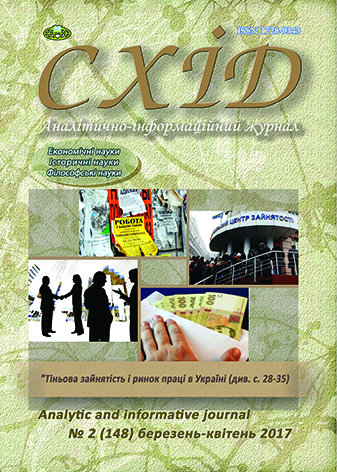Problem of shadow employment in the context of the labour market structural transformation
DOI:
https://doi.org/10.21847/1728-9343.2017.2(148).102663Keywords:
shadow employment, labour market, structural transformations, reduction of shadow employment, innovative development, increase of competitiveness, updating of tools and methods of state policyAbstract
The article studies modern problem of shadow employment in the context of structural transformations of the labour market. In the course of the study, the main manifestations, causes (economic, institutional, financial and social) were established and the consequences of the spread of shadow employment at the state level, at the enterprise and individual level. It is established that the shadow employment in Ukraine in recent years is rapidly spreading, covering a significant number of jobs in enterprises and organizations of the formal and informal sector of the economy. The state and dynamics of the spread of shadow employment in Ukraine are analyzed. It is proved that the informal sector of the economy essentially forms the capacity of the sphere of employment of rural residents. In cities, the situation is opposite - the conjuncture of the labor market and vacant workplaces can provide employment mainly in the official sector of the economy. Of course, it is the availability of jobs and acceptable working conditions that determine the main proportions of the distribution of workers between these spheres. In this context, it is important to emphasize that other factors often work, in particular, motivational ones - low level of wages, unreasonable inter-qualification ratio form active attitudes toward employment outside the formal sector of the economy with a high level of payment. The relationship between structural transformations in the labour market and shadow employment is revealed. The main directions of reducing the scale of shadow employment (formation of a policy of economic stabilization, ensuring the competitiveness of the economy and opportunities for innovative development, the formation and development of innovative infrastructure, the formation of competitiveness of the individual and the capacity for self-realization, updating tools and methods to reduce the scale of shadow employment) are proposed. Implementation of the proposed areas reduce shadow employment will ensure the improvement of the legal framework for the regulation of labour relations, rapid response to changes in demand and the formation of an effective system of forecasting national economic need for workers in view of changes in the structure of employment, contribute to the formation of a qualitatively new level of development of the national economy, securing additional competitive advantage to employers.
Downloads
References
Heiets, V. M. (2015), Barriers to industrial development based on innovation and opportunities to overcome them, in: Ekonomika Ukrainy, № 1, pp. 4-25 (ukr).
Kolot, A. (2009), Transforming Institute of employment as part of global changes in the social and labor issues, in: Ukraina: aspekty pratsi, № 8, pp. 3-14 (ukr).
Varnalii, Z. S., Honcharuk, A. Ya., Zhalilo, Ya. A. et al (2006), Shadow economy: the nature, characteristics and ways of legalization, Natsionalnyi instytut stratehichnyi doslidzhen, Kyiv, 576 p. (ukr).
Mazur, I. (2006), Deshadowing of the economy of Ukraine: Theory and Practice [monograph], Kyivskyi universytet, Kyiv, 239 p. (ukr).
Mandybura, V. O. (2003), «Shadow» economy of Ukraine and directions legislative strategies to limit, Kyiv, 135 p. (ukr).
Kharazishvili, Yu. M. (2011), The shadow employment and shadow Labor remuneration in Ukraine: estimates and projections, in: Stratehiia rozvytku Ukrainy (economics, sociology, law), № 4, pp. 171-182 (ukr).
Yurchyk, H. M. (2013), Evaluation scale and consequences of shadow employment, in: Sotsialno-trudovi vidnosyny: teoriia ta praktyka, № 1, pp. 138-143 (ukr).
World employment and social outlook 2015: The changing nature of jobs, available at: http://www.ilo.org/wcmsp5/groups/public/—dgreports/—dcomm/—publ/documents/publication/wcms_368626.pdf.
Demographic and Social Statistics of Ukraine. State Statistics Committee of Ukraine, available at: http://www.ukrstat.gov.ua.
Informational and analytical paper «Employment - the main task of the social partners», available at: http://www.ntser.gov.ua/split/files/content/Аналіт. довідка до п. 1 (профспілки).doc.
Major trends in the labor market. State Employment Service of Ukraine, available at: http://www.dcz.gov.ua/control/uk/ statdatacatalog/list/category?cat_id=30543.
Guidelines for the formation of national employment policies (2013), Technical Support Group on Decent Work and the ILO Subregional Office for Eastern Europe and Central Asia,Moscow (rus).
Downloads
Published
How to Cite
Issue
Section
License
Copyright (c) 2017 Larysa Shaulska, Nataliia Yakymova

This work is licensed under a Creative Commons Attribution-NonCommercial-NoDerivatives 4.0 International License.
1. Authors bear responsibility for the accuracy of facts, quotations, numbers and names used.
2. Manuscripts are not sent back.
3. The publisher does not always agree with the authors' opinion.
4. The authors reserve the right to authorship of the work and pass the first publication right of this work to the journal under the terms of a Creative Commons Attribution-NonCommercial-NoDerivatives 4.0 International License. This license allows others to distribute (copy) the published work for non-commercial purposes, provided there is mandatory attribution to its authors and a link to the first publication in our journal.
5. The authors have the right to conclude separate supplement agreements that relate to non-exclusive work distribution in the form in which it has been published by the journal (for example, to upload the work to the online storage of the journal or publish it as part of a monograph), provided that the reference to the first publication of the work in this journal is included.

